Delivering At the Point Of More Return
As upstream services have become more sophisticated, so, too, has the supporting return-path technology. In the plant, return paths based on low-cost Fabry-Perot (FP) lasers proved sufficient for set-top-box (STB) communications. However, laser technology advanced to meet new challenges of DOCSIS. This included higher power, lower noise FP lasers and the introduction of distributed feedback (DFB) lasers.
As DOCSIS 3.0 deployments continue to grow, so has confusion over technology options to support this era. A new crossroads, replacing FP vs. DFB debates, is around DFB and digital return (DR) systems. DR has known benefits to consider when planning upstream migration. However, it also comes with some important constraints.
Return, By the Numbers
The DOCSIS specification sets the minimum assumed upstream SNR at 25 dB. Table 1 compares theoretical capacity at this SNR vs. the DOCSIS physical layer rate, assuming 64 QAM, under various bandwidths.
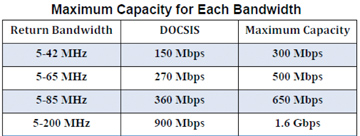 |
| DOCSIS And Capacity Vs. Bandwidth |
While DOCSIS specifications for upstream stop at 64 QAM today, it reportedly has been proved that 128 QAM and 256 QAM also can comfortably be supported using today’s CMTS and HFC technology.
The link between SNR and modulation efficiency is observed in Figure 1, where it is obvious that 256 QAM decision errors occur with less noise than 64 QAM. The lesser amount is precisely the 6 dB difference shown using SNRs of 25 dB and 31 dB. Demodulators also benefit from FEC, but Figure 1 properly identifies the impact of increased modulation efficiency. With new CMTS technology and today’s DFBs, 256 QAM robustly is supported by delivering sufficient link SNR, translating to higher theoretical capacity and practical throughput.
Fundamentals: Return Technologies
Analog Return
Analog links provide a robust, low-cost option expandable as bandwidth needs increase. DFB lasers are available wildly, covering an array of optical output power levels and WDM options. The lasers themselves typically are capable of contiguous bandwidth exceeding 3 GHz. In practice, transmitter bandwidth is determined by RF amplifiers and filters used for noise reduction and isolation. RF components in most legacy transmitters have upper-frequency capability of between 150 megahertz and 200 megahertz. The node diplexer is used to establish the upper band edge of the return. In some cases, changing the diplexer is all that is needed to expand capacity.
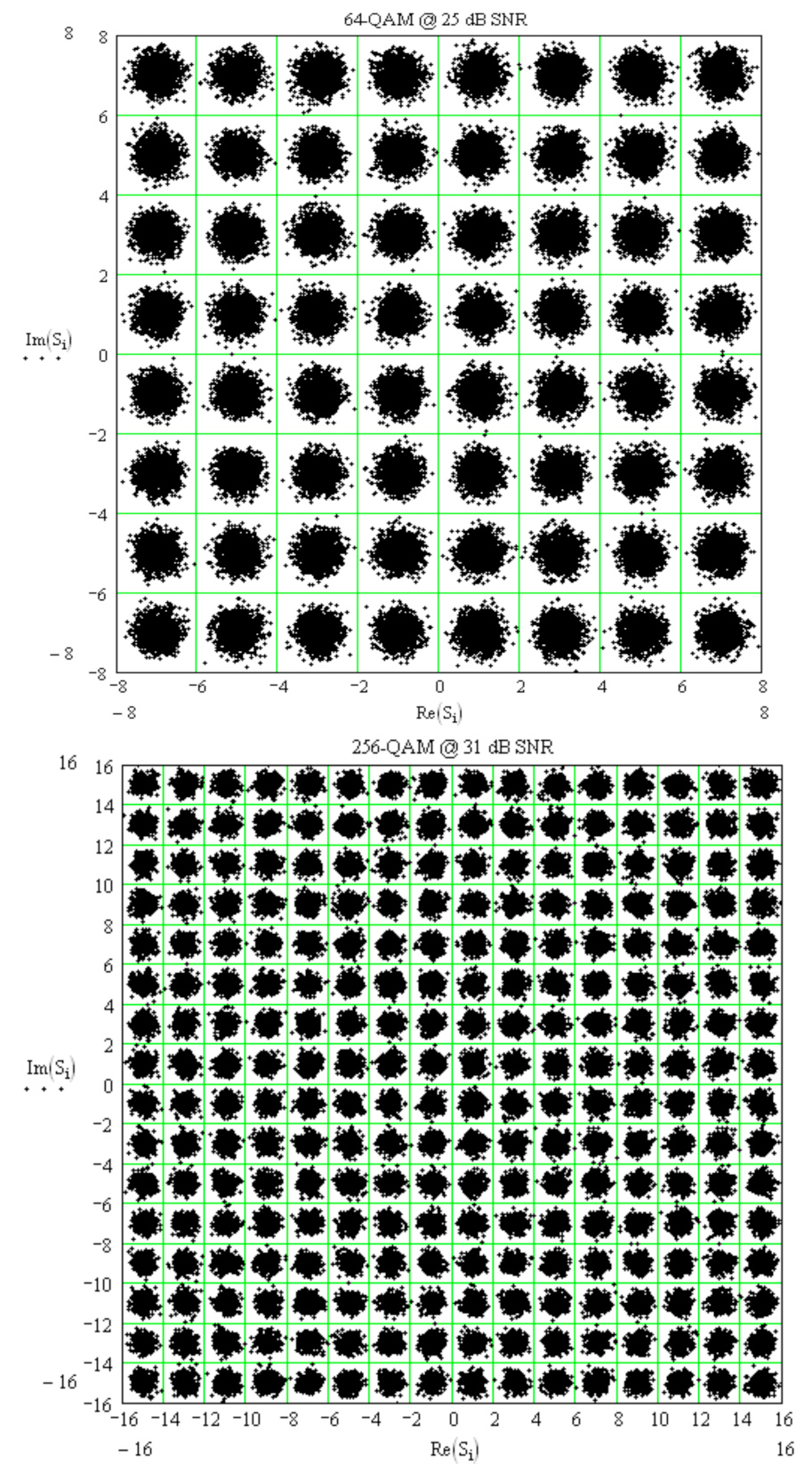 |
| The Next Phase Of Upstream Is Underway With 256-QAM |
SNR associated with the DFB transmitter is determined by a combination of laser noise (relative intensity noise [RIN]), output level and optical modulation index (OMI). On the receive side, noise in the form of equivalent input noise current (EINC) contributes to link SNR. Typical PIN diode detectors have a lower sensitivity limit of -16 dBm to -18 dBm. Newer designs have extended this to better than 26 dBm by improving EINC and limiting the total receiver bandwidth. Link reach, expressed as optical link budget, factors in transmitter level, fiber loss, passive losses of WDM mux/demux operations if applicable and receiver sensitivity.
Different analog-return solutions provide a range of reach capability. Table 2 illustrates a few common configurations and link budgets. These lengths cover the maximum distances for the majority of deployments by major MSOs.
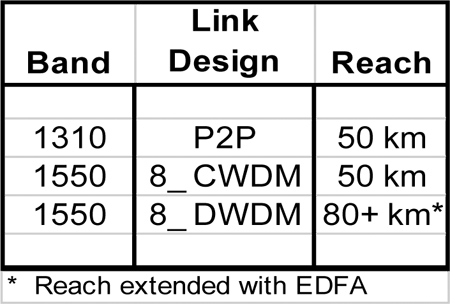 |
| Analog Return Reach Covers Most Practical Link Cases |
A primary advantage of analog return often is considered a disadvantage. Analog transport allows interoperable use of equipment from different vendors because the composite RF waveform is modulated directly onto the laser. The downside of this flexibility is that link gain and modulation depth (OMI) vary among manufacturers as well as according to link length. This requires operators to implement alignment processes and to adapt setup according to different vendor recommendations. Making analog return more “plug-n-play” is possible but at the cost of proprietary systems that subsequently are not interoperable.
Digital Return
Digital-return fundamentals are based on Nyquist Theory, which dictates a minimum sampling rate of 2x the highest frequency (2x bandwidth for IF systems). This sample rate is multiplied by the A/D resolution and the number of streams to transport to obtain the optical line rate for the digital transmitter.
Example: 5 megahertz-42 megahertz, 12-bit A/D, 2-channel transmitter (two RF streams, TDM)
Minimum Line Rate: (2 * 42) * 12 * 2 = 2.016 Gbps
To transport this rate with margin, a digital laser of at least 2.5 Gbps is needed. Lasers with this capability are available in a wide range of form factors, covering the full spectrum of ITU grid wavelengths.
SNR is a function of A/D resolution in DR and independent of link length. It also enables extended reach, beyond that of analog. The complete performance of any return system – analog or digital – is best represented for digital signal loading using noise power ratio (NPR). NPR is ideal for performance comparisons, showing SNR range and nonlinear performance simultaneously. Figure 2 shows the theoretical NPR at various A/D resolutions for DR, including the well-understood 6 dB/bit relationship. Note that common, square QAM formats (see Figure 1) differ by 6 dB in SNR at fixed error rate.
Figure 2 also shows the potential for DR to provide improved SNR at the price of added resolution, transmitter rate and, thus, possibly cost.
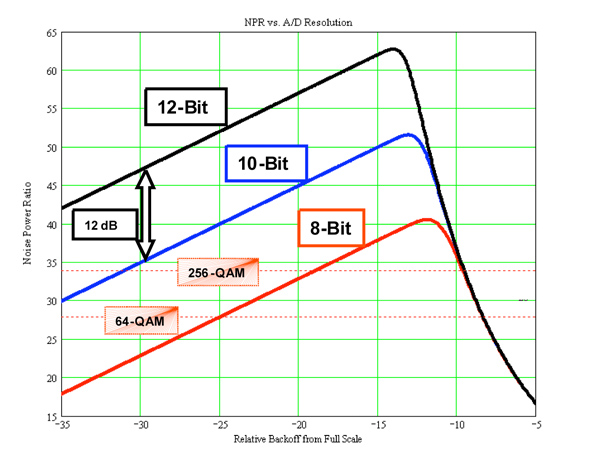 |
| NPR Vs. A/D Resolution For Digital Returns |
Properly functioning (error-free) DR is not affected by optical noise from a NPR perspective. NPR instead is determined by resolution used and the A/D’s ability to achieve this resolution with precision, as governed by its effective number of bits (ENOB). The NPR signature also potentially is modified by signal processing algorithms applied.
A key disadvantage of digital return, exacerbated today with the expectation of upstream spectrum growth, is the dependency between RF bandwidth and sampling rate, a key design and cost parameter, as shown in Figure 2. A further drawback is that implementation is different for every manufacturer; each vendor’s system is proprietary and not interoperable. This disadvantage can be an advantage to operations. Because the transmitter and receiver are matched by design, there are minimal setup uncertainties, and optical-link length and receiver RF output are not interrelated. Thus, digital return is considered plug-n-play.
Upstream Capacity
While not growing as rapidly as downstream, upstream rates and traffic still are increasing. It can be quantified when today’s bandwidth will be exhausted. There are two primary avenues for new capacity – more RF bandwidth, and more bandwidth efficient modulation.
Upstream Bandwidth Expansion
Bandwidth expansion discussions in the industry include deploying 85 megahertz mid-split, and consideration for a subsequent 200+ megahertz “high” split extension – the latter to achieve 1 Gbps total. The former is today’s solution, while the latter is supported ably for longer-term growth (see Table 1). As discussed, analog systems can accommodate these bandwidths with minimum, if any, changes.
For DR, however, the sampling rate and laser data rate increases in difficulty and cost with new bandwidth. Each significant bandwidth increase may entail a new design. Table 3 shows the optical-line rates of various combinations of A/D resolution and upstream bandwidth for a typical two-channel system.
 |
| Digital Return: A/D Resolution, Bandwidth And Optical Line Rate |
Another factor to consider when expanding upstream bandwidth is the decrease in SNR/NPR associated with increased signal loading. Figure 3 shows calculated minimum NPR performance of an analog link vs. bandwidth. Reduction in NPR due to expanded bandwidth potentially could be compensated using a higher-output-power DFB.
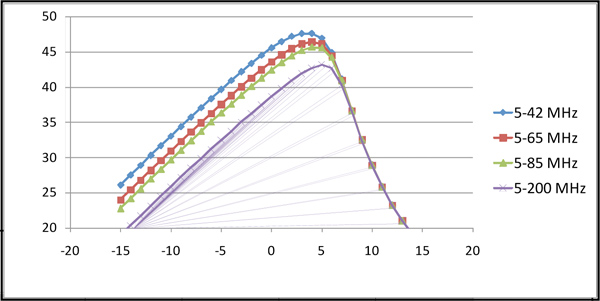 |
| Relative NPR Vs. BW For Analog Link |
For digital returns, an increase in bandwidth often comes with a penalty to A/D performance in terms of ENOB, with each half-bit loss incurring 3 dB performance degradation. This NPR loss, combined with more bandwidth efficient modulations, may dictate use of more A/D bits.
For comparison, Figure 4 shows measured NPR performance of a typical DFB-RPR return of nominal link length, using a 2 mw DFB. A DR system using 10 bits also is shown, in each case over a 65-megahertz split. This data confirms the general equivalence of a DR that achieves 10 bits of performance and nominal DFB returns of typical link length. It is apparent that both show comfortable margin to the QAM thresholds shown.
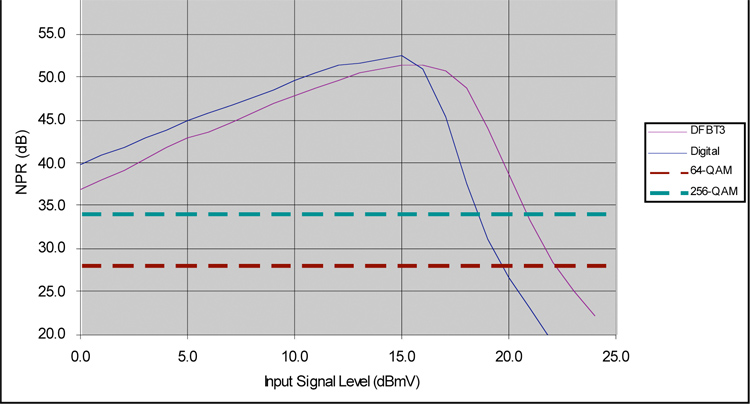 |
| Analog DFB And Digital Return Performance Parity |
The performance parity shown in Figure 4 contradicts misleading claims that digital solutions alone provide sufficient performance for upstream growth. Indeed, continued bandwidth growth likely favors renewed interest in analog solutions or, longer term, next-generation systems that terminate modulation in the plant.
Impact Of Higher Modulation Formats
DOCSIS upstream specifications recognize QPSK through 64-QAM formats. However, it generally is known that commonly used DOCSIS chipsets embed 256-QAM functionality. 256 QAM offers 33-percent increased modulation efficiency for the same bandwidth as 64 QAM. The drawback is the 6 dB higher SNR. For 128-QAM, about 17-percent more throughput is available for about 3 dB.
With high-performance return paths (see Figure 4), CMTS noise performance becomes critical. A recent demonstration between Motorola and Cox Communications evaluated new-generation, low-noise CMTS receivers. Using a N+3 cascade, a DFB return was loaded with three 6.4-megahertz, 256-QAM channels and S-CDMA channels over 5 megahertz to 42 megahertz, providing 141 Mbps of usable throughput. Using a 85-megahertz return and 256-QAM channels, 400 Mbps was achieved.
Figure 5 shows the combined NPR performance of the HFC return and new CMTS receivers via a 5-megahertz-to-85-megahertz return bandwidth. Legacy DOCSIS receivers and the latest generation of low-noise receivers are compared. Performance using legacy receivers is 64-QAM-capable, but not well-suited to 256 QAM, as expected. However, it is clear that new-generation CMTS receivers, using the same DFB returns, can support 256 QAM with substantial practical operating margin. These end-to-end results once again refute assertions about the limitations of analog return paths for future growth.
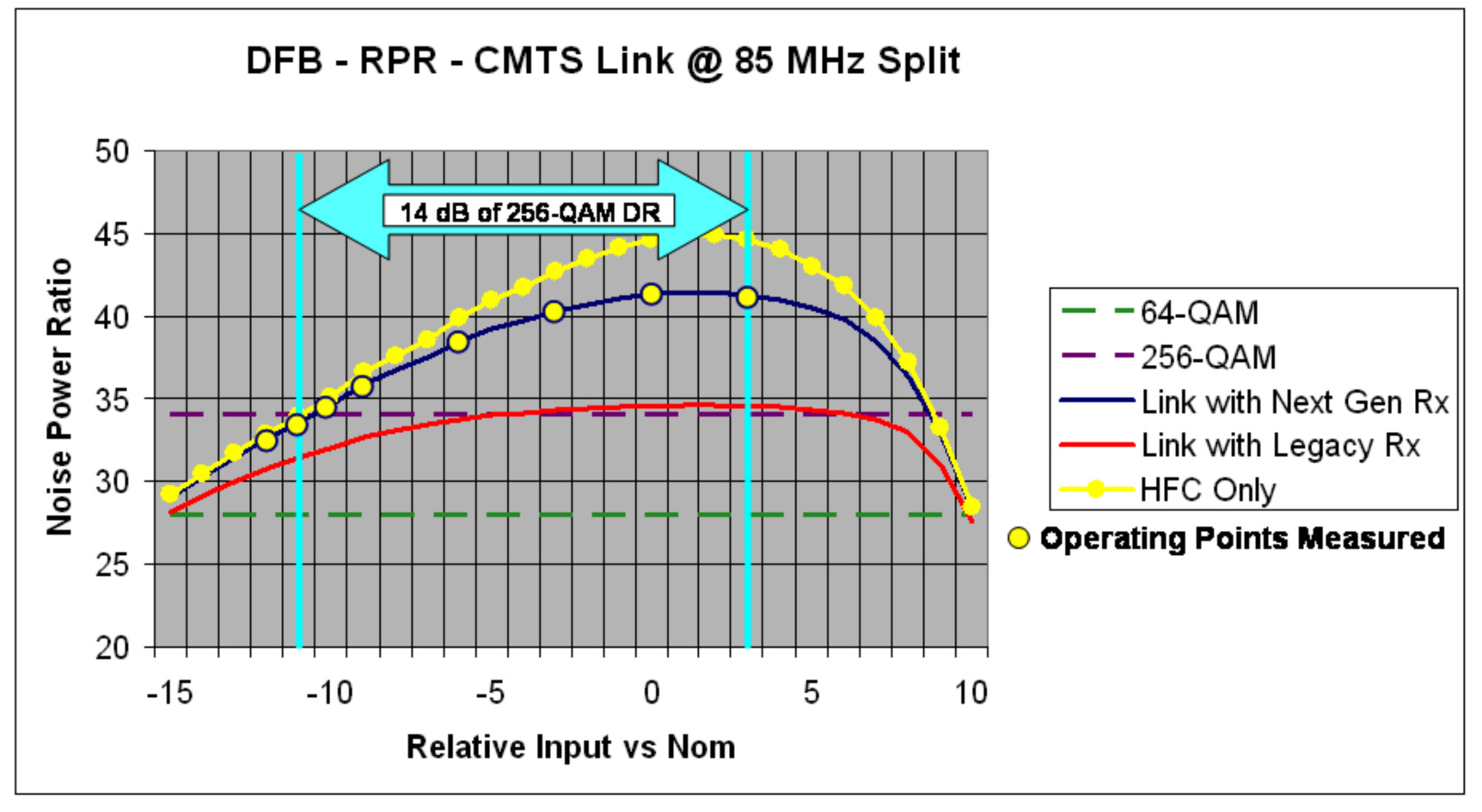 |
| Proved Solution: 256 QAM Delivered Via A 85-Meg Mid-Split |
Lastly, it can be shown in Figure 5 by extrapolation that even high-split performance, via 200 megahertz of bandwidth (a 4-dB offset) would also exceed the 256-QAM threshold shown. This emphasizes the amount of latent performance and, thus, growth runway, provided by this combination of available technology.
Theoretically, DR is capable of supporting 256 QAM via a 85-megahertz return as Figure 2 and Figure 4 suggest. However, 85-megahertz DR systems aren’t available today. This again points to the issue of upgradability of DR systems. While analog returns can relatively easily be repurposed for extended bandwidth, DR systems typically require design iterations due to the sampling rate impacts of adding RF bandwidth.
Parity And Differences
Figure 5 unmistakably demonstrates the ability to support next-generation upstream requirements with analog DFB solutions. Indeed, only analog systems today have been proved in the field to deliver 256 QAM via a 85-megahertz mid-split bandwidth.
Parity between analog and digital solutions exists for several key considerations, underscored by Figure 4. Each offers wavelength options, performance, modularity and bandwidth, and each typically reaches that support the vast majority of current DOCSIS 3.0 initiatives. This parity and the closing gap in cost differential will continue, even as operators take advantage of a mid-split.
However, key differences exist. As shown, as upstream bandwidth grows, differences between analog and digital become more noticeable. DFB transmitters have considerable latent bandwidth expansion and dynamic range capability. Digital returns may require replacement associated with new sampling rate requirements, even for the initial extension to 85 megahertz. As bandwidth expands beyond this, optical-line-rate requirements could drive much higher digital costs, especially in comparison to analog alternatives. Furthermore, higher SNR requirements for 256 QAM may exceed the capability of 8-bit DR systems and could challenge low-cost, 10-bit solutions that don’t deliver true 10-bit performance.
Higher-order modulation supported using at least 85 megahertz appears to be the leading near-term upstream solution for new capacity, and one capable of even further growth. CMTS’s and modems are making this a reality today via current analog DFB returns. Except for extremely long-reach links, these DFB-based systems have the flexibility to meet a wide range of possible future capacity enhancements, and they are poised to launch cable through the Gigabit upstream era.
Dr. Robert Howald is a Fellow/Technical Staff and Phil Miguelez is director/Access Networks Engineering at Motorola Mobility. Contact them at [email protected] and [email protected].